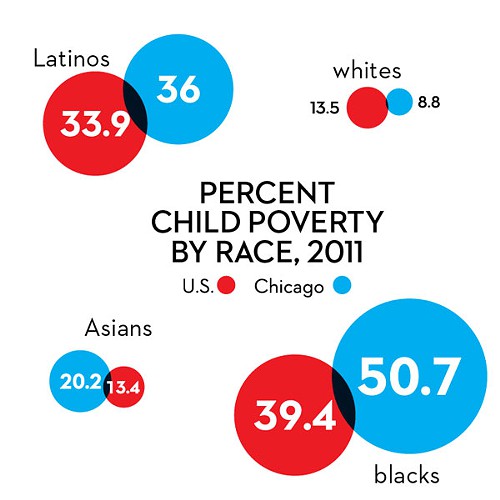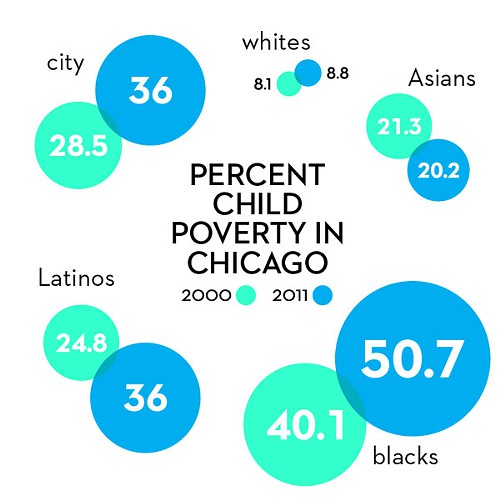by Steve Bogira
I noted recently that more than one in three Chicago children are living in poverty, according to newly published census data. But a closer look at those figures shows that “one in three” hides a striking inequality.
Fewer than one in 11 white kids here are living in poverty—compared with more than one in two black kids.
The news regarding white Chicago kids, in fact, is good: their poverty rate is significantly lower than the national rate for white kids. But for black, Asian, and Hispanic children, the poverty incidence is higher in Chicago than for their counterparts nationally:

Moreover, the racial gap in child poverty in Chicago appears to be growing:

As the numbers show, child poverty has declined for Asians and gone up modestly for whites since 2000—while climbing significantly for blacks and Latinos.
What does Mayor Emanuel think of this? I wish I could tell you, but the mayor’s office has yet to respond to questions I posed ten days ago. I asked how the mayor is seeking to address not only child poverty, but the more than five-to-one disparity in the black and white rates.
Emanuel didn’t create this gap, of course. There are similar problems in many other cities. Their historical roots are deep. They’re fed by segregation in our neighborhoods and schools. Even if Emanuel’s top priorities were attacking poverty and racial inequality, he wouldn’t be able to solve them overnight—or in one term, or in two.
But Chicago seems headed in the wrong direction.
And is it acceptable to have one in two black kids in poverty? Would it be acceptable if it were one in two white kids?
***
Beginning today, I’ll be posting here every Thursday on segregation. I’m interested in more than race and class. In the U.S., we’re greatly segregated by age. Is that separation growing? What impact does it have? When does segregating by sex make sense, and when doesn’t it?
But I’ll focus primarily on racial and economic segregation, which in Chicago march arm in arm. They’ve appalled and fascinated me for as long as I can remember.
I grew up on the white south side, my dad worked on the black south side, and there was a sharp border between the two (Halsted, then Racine, then Ashland, then Damen). There was similar segregation, if less intense, elsewhere in Chicago as well.
I was born in 1954, so this was quite awhile ago. Why have we still not gotten over it?
The racial makeup of the city is more complex today, largely because there are more Asians and far more Latinos, who sometimes serve as buffer groups between whites and blacks. But there’s still a vast south-side section that’s almost entirely black, and a similar, smaller section on the west side. Most of the city’s African-Americans live in these two areas. The city’s leading causes of suffering—fires, foreclosures, crime, poor health, high dropout rates, joblessness—have always been centered in these neighborhoods.
The problem isn’t merely poverty. It’s poor families surrounded by poor families—segregation’s legacy. Climbing out of poverty is hard, but it’s especially hard when it’s all you know growing up.
There’s every reason to ignore our city’s racial segregation. We long ago grew accustomed to it. It seems impossible to change. For most white people, it’s somebody else’s problem.
But ignoring it only lets the suffering continue.
Tags: child poverty, racial inequality, segregation, Mayor Emanuel
